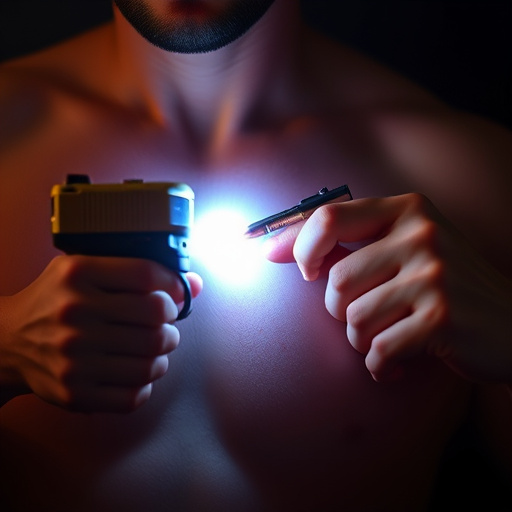Stun guns (electronic control devices or ECDs) disable assailants through high-voltage, low-current electric shocks disrupting muscle control. While direct contact increases effectiveness, it’s not always required – some models use projections for remote activation through clothing. The debate over “does a stun gun have to touch skin” highlights varying views on optimal deployment strategies. Proper training is essential as power levels, target size, body composition, weather, and protective gear can impact performance.
Stun guns, designed to incapacitate through electric shock, have sparked debates regarding their effectiveness and safety. This article delves into the mechanics behind these devices, addressing the age-old question: does a stun gun have to touch skin to be effective? We explore the nuances of contact versus non-contact stun technologies, dissecting their respective pros and cons. Understanding these dynamics is crucial for both users and policymakers in navigating the complex landscape of personal defense.
Understanding Stun Gun Functionality and Its Mechanism of Action
Stun guns, also known as electronic control devices (ECDs), are designed to temporarily incapacitate a target by delivering an electric shock. Their functionality is based on the principle of disrupting muscle control in the body through a high-voltage, low-current electrical pulse. When activated, the stun gun emits a strong charge that can disrupt the electrical signals in the nervous system, causing muscles to contract involuntarily and leading to temporary paralysis or disorientation.
The mechanism of action doesn’t necessarily require direct contact with the skin. Stun guns often use projections or probes to deliver the electric shock from a distance. These projections penetrate the target’s skin, allowing the current to flow through and disrupt nerve impulses. This design feature means that even if the stun gun isn’t in direct contact with the skin, it can still be effective in neutralizing an assailant by targeting muscle tissue and neural pathways.
The Contact vs Non-Contact Debate: Does Skin Contact Really Matter?
There’s been an ongoing debate regarding the effectiveness of stun guns, with a significant question being whether the device needs direct contact with the target’s skin to deliver a stunning effect. Some advocate for non-contact activation, believing that the electric charge can penetrate clothing and directly affect the body. However, others argue that skin contact is crucial for optimal results.
The concept of skin contact as a requirement stems from the way stun guns work—by disrupting muscle control through an electric current. Direct contact ensures the current flows unimpeded, increasing the chance of successful immobilization. Yet, proponents of non-contact activation suggest that advanced technologies can generate enough energy to overcome resistance from clothing or skin, making traditional contact unnecessary. This discrepancy highlights the complexity surrounding stun gun effectiveness and raises questions about the optimal deployment strategies in real-life scenarios.
Exploring the Effectiveness and Limitations of Stun Guns on Humans
Stun guns, also known as electronic control devices (ECDs), operate by delivering an electric shock to immobilize a target. The effectiveness of a stun gun lies in its ability to disrupt muscle control and cause temporary paralysis, allowing users to subdue an assailant. However, the performance of these devices is influenced by several factors, including their design, power output, and application technique. One common misconception is that a stun gun must touch the skin to be effective; while direct contact increases impact, it’s not always required. Some models use projections or probes to deliver an electric charge from a distance, making them viable options in situations where direct physical interaction is impractical or unsafe.
Despite their effectiveness, stun guns have limitations. Their power may vary widely among different models and brands, affecting the intensity of the shock. Additionally, factors like target size, body composition, and the use of protective gear can influence how well a stun gun performs. Moreover, weather conditions, such as moisture or cold temperatures, can impact device functionality. It’s crucial to note that while stun guns offer non-lethal force options for self-defense, proper training and understanding their mechanics are essential for safe and effective use.
